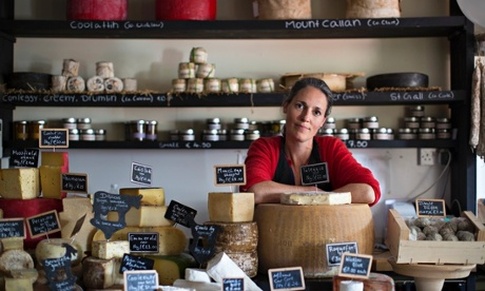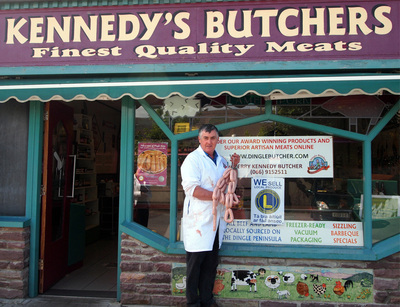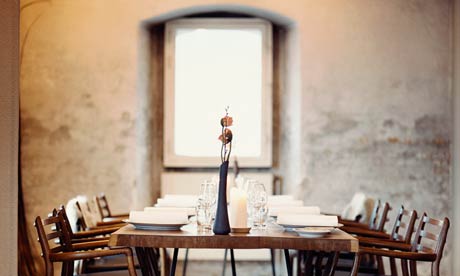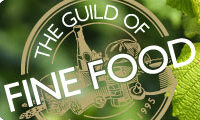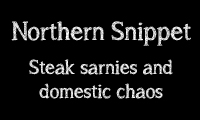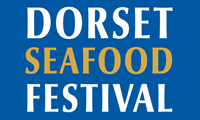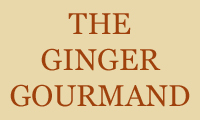|
Miriam Phillips The Guardian 31 January 2015 With a coast jumping with seafood, great local produce and a new wave of stylish hotels, chefs and foodies are flocking to Dorset. We round up the very best of the county’s restaurants Seventeen years after Hugh Fearnley-Whittingstall established his River Cottage HQ on the Devon-Dorset border, there’s been a slow but subtle change in the way Dorset is perceived by foodies and chefs. “Dorset has gone from being a sleepy county to a place where people and chefs are gravitating,” says James Golding, chef-director of The Pig on The Beach, which opened in Studland last summer to great acclaim. The next big thing to hit Dorset’s shores will be the Seaside Boarding House, which is scheduled to open in mid-February. The eight rooms will cost £200 B&B; the menu is still under wraps, but “will offer something for everyone, from a picnic hamper for the beach, to a casual lunch to a more formal dinner”. At Burton Bradstock and overlooking Lyme Bay, it has already been dubbed “the Groucho on the Sea” as it’s the latest venture by Mary-Lou Sturridge and her business partner Anthony Mackintosh, who founded the members-only Groucho Club in Soho, London, in 1985. “When I moved here six years ago, there was nowhere to go for a really good meal,” says Sturridge. “That’s no longer the case. We’re lucky to live in such a wild county with lots of smallholders and are blessed with produce.” Here’s our pick of the best eating the county has to offer:
The Casterbridge, Dorchester Mat Follas, the 2009 winner of BBC MasterChef, has experienced a roaring success since he took over the restaurant at this small hotel in the county town of Dorchester a year ago, after moving from The Wild Garlic in Beaminster, which won over the critics. At the Casterbridge, he cooks only on a Friday and Saturday evening and offers a three course-tasting menu for £29.50 or a six-course menu for £47.50. Dishes might include partridge crown confit with smoked aubergine puree and horseradish pesto. The restaurant is small and cosy, with no pretention, tablecloths or large menus. Follas has also helped launch The Jailhouse Cafe The Verne on Portland, which is run by prisoners on day release and is open to the public. • 01305 264043, thecasterbridge.co.uk
0 Comments
24/10/2014 0 Comments Nature's Wild PantryWords: Mat Follas | Images: Jonathan Cherry The Guardian / Enterprise open road 24 October 2014 The lanes, beaches and fishing ports of west Dorset provide rich pickings for our foraging friends. Click here to launch the story A cool, late September morning found me and a couple of friends, fellow chef Dean Edwards and Tam, cooing with delight in front of a blackberry hedge. An exciting day wandering the west Dorset countryside ... click here for more
11/8/2014 0 Comments Mat Follas: My taste of IrelandMat Follas theguardian.com 11 August 2014 A leisurely arrival set the tone for Mat Follas’ culinary adventure in west Cork, which saw him forage for sea spaghetti and sample fresh smoked fish Mat Follas samples local produce in Cork’s English Market. Photograph: Tom Parker My easy-going arrival in Cork sets the tone for the rest of my stay in Ireland. It takes all of five minutes to collect my bags and I’m at the desk to get my rental car - I spend longer trying to get my satnav to recognise the town of Ballydavid where I’m staying that night. Heading off I realise how leisurely the traffic is, and during my whole stay in south west Ireland I notice that there are plenty of cyclists exploring the area too. It means you slow down and enjoy everything at a leisurely pace too. The towns, with their multi coloured houses and pubs and shops straight off a tourist postcard are stunning and the rolling countryside just shouts ‘slow down, relax’. My afternoon tea stop, in Killarney is popular with visitors enjoying horse and cart rides, but I’m totally disarmed when I get out of my car, there is a sincerity and lack of cynicism that I’d normally associate with a tourist location that surprises me, a recurring theme throughout my visit. A fabulous ice cream at Murphy’s Parlour and a chat with one of the cart drivers who poses for a picture sees me away with a smile. Dingle, one of the many picturesque towns along the Wild Atlantic Way, is not short on photo opportunities. Photograph: Mat Follas I drive on to Dingle, and am literally stopped in my tracks by the stunning scenery as I approach the peninsular. It erupts suddenly into a mountainous land and I drive along a stretch of the Wild Atlantic Way - one of the world’s longest coastal driving routes - to Dingle, stopping to take photos and walk on the sandy beaches. It’s a Sunday night and, by the time I arrive at Gorman’s B&B, I am one and a half hours late for their 7pm dinner sitting, however my lateness isn’t mentioned and they offered to cook anything from the menu for me. What a wonderful welcome. I left it up to the chef to choose and she cooked me the best lamb stew I think I’ve ever eaten. Unsurprisingly, they’ve got a well-deserved AA rosette. In Dingle the next morning, I’m met by Martin Bealin of Global Village Restaurant who generously spent most of the day with me showing me the sights. These include the local brewery where they make Tom Crean’s, a very good Pilsner style beer, then onto the Dingle distillery where they’re making a name for themselves producing an superb gin, originally produced to maintain the cash flow whilst their whiskey was maturing. It’s a few years yet before the whiskey will be ready but if it’s anything like the gin, it’ll be very good indeed. An hour with Maya Binder, a Swiss-trained German cheese maker who produces some wonderful soft farmhouse cheeses is heaven to a cheese lover like me. Maya Binder of the Little Cheese Shop. Photograph: Tom Parker Dinner at Martin’s restaurant that night is exceptional, better than some Michelin starred places I’ve eaten at. A few drinks with the local food fraternity in the pub next door, that also doubles as a hardware store, sees me agreeing to return for their food festival between 3-5 October and his new venture, the Dingle Cookery School.
I didn’t want to leave Dingle, it’s a special place; a town of 1800 with 52 food establishments, amazing producers and a happy, relaxed vibe, I look forward to returning. The next stop, after an inspiring drive along another stretch of the coast and I’m searching for the famous Woodcock Smokery, winner of numerous awards including several three star awards from the Guild of Fine Foods. I find it, and the owner, the wonderful Sally Barnes, on a rough track in the middle of nowhere and within 20 minutes I know I’ve met a friend, we’re exchanging inappropriate jokes and stories of travels over a mug of builders tea in her kitchen. She’s an amazing lady and her passion for both the products she makes and conservation are an inspiration. It was a delight to learn from her and meet her granddaughter who works there too, her daughter is taking a break to climb mountains for charity, what a family! A great dinner that night at Mary Anne’s pub in nearby Castletownsend, a really good fish pie and plaice stuffed with crab and leek, they’re packed full on a Tuesday night and I’m pretty sure I only get a table due to the owner loving MasterChef, and having a good memory. My final day sees me heading into Cork to see the English Market. This is without doubt the best food market I’ve been too in the UK or Ireland. The produce is perfect, the prices are better than I pay wholesale in the UK and the stall holders know their products. The best way to experience the market is to lunch at Kay Harte’s Farmgate Cafe which sits on a balcony above the market watching a constant changing scenery below, all of her produce comes from the market itself and my lunch of smoked and cured Mackerel and Herring and a plate of the best liver and bacon leaves me full and happy for the rest of the day. A night of pure luxury at the wonderful Hayfield Manor in Cork sees me heading home to Dorset the next morning with fond memories and plans to return. 10/8/2014 0 Comments Mat Follas' taste of IrelandThe Guardian 09 August 2014 TV chef Mat Follas is well-known for producing hearty meals using foraged ingredients. On a trip to Ireland, he finds the country’s ‘natural larder’ is a rich source of inspiration for kindred wild-food enthusiasts Mat Follas enjoying Kinsale’s farmers market. Photograph: Tom Parker My first taste of Murphy’s honeycomb caramel ice cream, in pretty, bustling Killarney, set the tone for a holiday full of edible revelation. Handmade by Sean and Kieran Murphy using local ingredients, including the milk of the rare Kerry cow, its rich flavour and creamy texture was simply superb. And if those little chunks of honeycomb transported me back to my homeland – where the similar hokey-pokey ice cream is practically a national dish – it was a pleasure to open my eyes and find myself back in south-west Ireland. I couldn’t resist a second helping when I got to Dingle, where at the original Murphy’s shop I discovered the divine pairing of lemon curd and gin-and-tonic flavoured ice creams – the gin distilled in Dingle, naturally. The sun hadn’t stopped shining since I left Killarney and already I had sand between my toes: driving west along a road sandwiched between mountains and sea, I hadn’t been able to resist parking up at Inch beach and striding along the vast sands. Dingle has 1,800 residents and 52 places to eat. One of them is Global Village, the award-winning standard bearer for the peninsula’s ever-growing culinary reputation. Its chef-proprietor Martin Bealin took me to visit his favourite shops and suppliers, including Maja Binder’s The Little Cheese Shop. Her handmade Dilliskus, a semi-hard cheese enhanced by the salt and iron of hand-gathered seagrass, bowled me over. That got us talking about seaweed. And soon I was heading to Dingle harbour with Bealin, a kindred wild-food enthusiast who confessed that his restaurant and soon-to-be-opened Dingle Cookery School didn’t leave him much time for foraging. Against the backdrop of Dingle Bay we scoured the sandy shore for wild plants and sea vegetables. My first taste of sea spaghetti lived up to its name – greeny brown strands that were deliciously al dente – and I did a double take when I spied a great bush of purple vetch thriving on the seashore. In this sunny corner of Ireland, warmed by the Gulf Stream, the hedgerows sparkle with bright wild fuchsias. Thanks to Bealin, I now know that if you squeeze these edible flowers you can eke out the clear, honey-sweet nectar known in Ireland as “God’s tears”. On Bealin’s tasting menu that night, a single fuchsia flower balanced perfectly the sweetness of a fresh-from-the-boat turbot fillet. And there was another familiar flavour on the plate: our own foraged sea beet leaves, fried in tempura batter. Gourmet food from ‘nature’s larder’ at Global Village. Photograph: Tom Parker Bealin and his fellow chefs have access to an enviable natural larder: seashore plants, Atlantic seafood, meat slowly reared on the lush grasses. But the other crucial ingredient of Cork and Kerry’s rich food culture is an old-fashioned way of doing things: not because it’s now lucrative to be “local” or “artisan”, but because that’s the way they’ve always done it.
Sally Barnes, of the Woodcock Smokery in Castletownshend, epitomises this approach. A leading light of Ireland’s slow-food movement – which, as an alternative to fast food, aims to promote local, sustainable produce – Barnes uses only wild fish and does everything, from pin-boning to salting and slicing, by hand. The resulting smoked salmon, infused with the scent of smouldering native hardwoods, is exceptional. My diversion to meet her not only justified resting my bones at the glorious Liss Ard country estate, but also took me via Cork’s stunning south-western coastline – and I resolved to come back on my motorbike to ride the Wild Atlantic Way. Food producers such as Barnes, who is passing on her skills to her daughter and granddaughter, are the lifeblood of Cork’s celebrated food towns. Bright and boaty Kinsale, for example, has its Good Food Circle restaurants (and many more great eateries besides), but its brightest jewel is the weekly farmers’ market. There, among the mutton pies and sourdough breads, I made a beeline for the two expatriate Italian chefs cutting fresh beetroot and rocket tagliatelle from their handmade dough. Thirty miles north, in Cork city, I marvelled at the most impressive covered food market I’ve seen in the northern hemisphere. The English Market has been operating since 1788, and what struck me about it, aside from the sheer quality of its local produce, was that it is a real, honest market where workers call in at the end of the day to buy their dinner. At the hub of it all is Kay Harte of the Farmgate Café, whose menu is based exclusively on market produce. She cooked me a perfect plate of sliced lamb’s liver and bacon, but not before I’d squeezed in an appetiser of smoked and pickled fish from Pat O’Connell. He is the fish merchant who reduced the Queen to hoots of delight during the royal visit of 2011. It was a mother-in-law joke that set her off, he said. But I’m sure that the sights, smells and flavours of this bountiful Irish market must have had something to do with it.
18/9/2010 0 Comments A walk on the wild side
8/4/2010 0 Comments Fire your imagination
|
Blog Categories
All 2008 2009 2010 2011 2012 2013 2014 2015 2016 2017 2018 Bramble Cafe & Deli Conde Nast Traveller Food And Travel Magazine Food Judge Foraging Kai We Care Masterchef Mat Follas Olive Magazine The Casterbridge The Guardian The Independent The Telegraph The Times The Wild Garlic Things I've Written YouTube / Vimeo Mat likes ...
|
|
For Mat Follas books and personal appearances, please contact Gidday Ltd
E: [email protected] Company Registration No. 9028088 Registered address: Gidday Ltd, Verulam House, Unit 1 Cropmead, Crewkerne, Somerset TA18 7HQ |
|
|
© 2014 Mat Follas. All rights reserved
|






